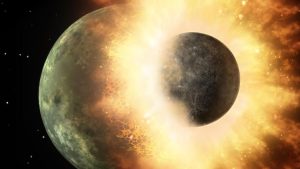Moon’s Origin Story: Its Mother Died After Giving Birth. She Was Earth’s Sister
A new study reveals that Theia, the planetary body that collided with early Earth to form the Moon, was Earth’s ‘sister’ from the inner Solar System, formed closer to the Sun. This discovery, based on iron isotope analysis, provides the first substantial evidence of Theia’s origins and explains the Moon’s dry composition.
Key Takeaways
- Theia, a Mars-sized body, collided with proto-Earth 4.5 billion years ago.
- New research confirms Theia originated in the inner Solar System, closer to the Sun than Earth.
- Iron isotope analysis of Earth, Moon, and meteorite samples provided crucial evidence.
- Theia’s composition may represent a “missing reservoir” of inner Solar System material.
- This explains why the Moon is drier than Earth’s mantle.
The Giant Impact That Formed Our Moon
Around 4.5 billion years ago, a catastrophic collision between early Earth and a Mars-sized planetary body called Theia created our Moon. This event, known as the Giant Impact Hypothesis, completely destroyed Theia, with its remnants becoming part of both Earth and the Moon.
Solving Theia’s Mysterious Origins
Researchers from the Max Planck Institute for Solar System Research and the University of Chicago analyzed isotopic fingerprints of iron in 15 Earth rocks, six Moon samples from Apollo missions, and meteorites. Their study, published in Science, provides two key findings: Theia was part of the inner Solar System and formed closer to the Sun than Earth.
Previous studies couldn’t determine whether Theia was carbonaceous or non-carbonaceous, or where it originated in the Solar System. The new iron isotope analysis finally provides substantial evidence that Theia originated in the inner Solar System.
The Missing Reservoir Theory
Lead author Timo Hopp explained that material from Theia might be part of a “missing reservoir” not sampled by known meteorites. “The material that formed in the inner Solar System closer to the Sun than the Earth can be called a missing reservoir which is not sampled by meteorites,” Hopp told IndiaToday.in.
“The reason for this might be that all of this material was accreted/consumed by the planets in the inner Solar System, like Mercury, Venus and Earth. One could speculate that if we ever get a sample from Mercury or Venus, we might find a larger contribution of the unsampled material in them compared to the Earth.”
Why Iron Isotopes Matter
The researchers used reverse engineering through iron isotope analysis because iron ratios differ between carbonaceous and non-carbonaceous meteorites. When results showed Earth and Moon samples fell within the non-carbonaceous range, it confirmed both bodies were built mostly from inner Solar System material.
“Iron is a siderophile, meaning it tends to go into the metallic cores of planets like the Earth,” Hopp explained. “Therefore, a large fraction of iron in present-day Earth’s mantle was likely delivered at the end of the planet’s accretion by Theia.”
Explaining the Moon’s Dry Composition
Since Theia formed closer to the Sun in a hotter region with less water, this explains why the Moon is drier than Earth’s mantle. Hopp noted that while Theia’s origin might contribute to the Moon’s dry composition, “more likely, the Moon lost most of the water and volatiles during the giant impact, which melted the Earth and the Moon’s mantles into magma oceans.”
As evidence continues to emerge, it becomes clear that the Moon’s serene appearance today belies its violent birth from Earth’s long-lost sister planet.





